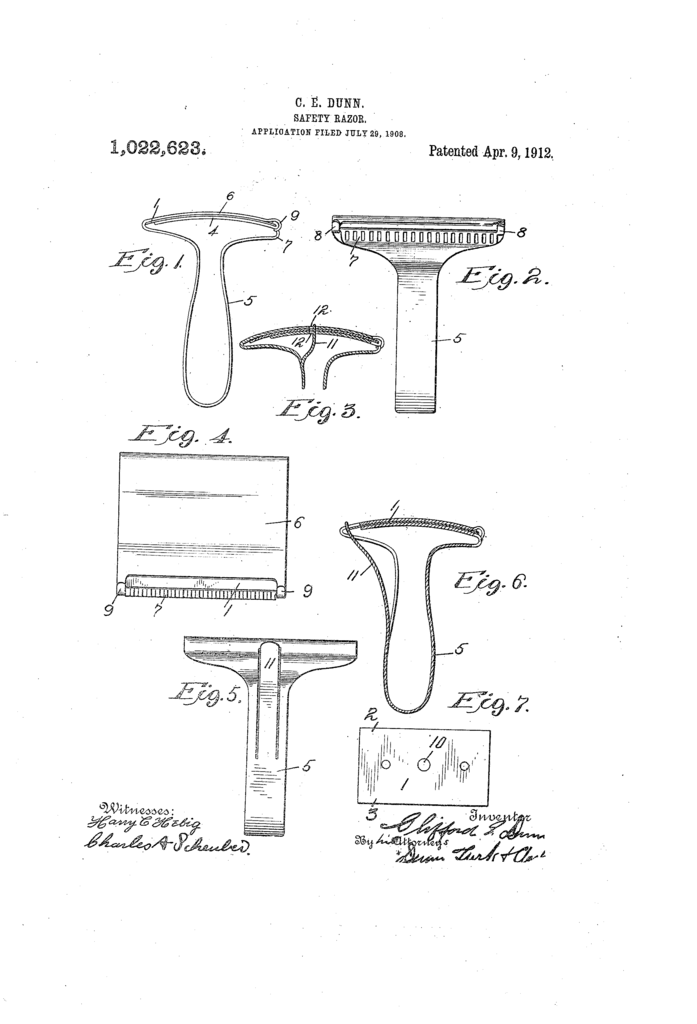Recently razors.click tweeted about a razor patent that I’ve never seen before and it has some really intriguing features. It was filed in 1908, and the patent granted in 1912. It’s a patent by Clifford E Dunn, whom we have meet before.
One of described forms is a single edge razor using a double edge blade – not a unique idea by itself, but this is one of the earliest ones I know of. That design is set up to use Gillette’s three hole blade1 – thus avoiding having to reintroduce yet another blade on the market. Other forms can use a single edged blade – the early Gem blade might work, or a Christy style blade.
On to the patent, which described – according to the text – “certain new and useful Improvements in Safety-Razors”. To quote:
My invention relates to improvements in safety razors and safety razor frames, the object being to provide a cheap, simple, and effective frame which can be easily constructed, and which will be simple in operation.
US patent 1,022,623
It is also the object of my invention to provide a frame wherein a double-edged blade can be used, each edge alternately, and wherein provision is made for protecting from injury the edge which is not being used.
The frame – what most people today would call the razor – was a stamped and folded piece of sheet metal. This would have to be fairly springy material, since the razor relies on springs to say closed. Brass and spring steel springs2 to mind as good choices.

Variations
The patent describes three different ways to make the razor, of various complexities.
First variation
The first way is shown in figures one, two and four, where the whole razor acts like a spring. The rear half pushes the cutting edge of the razor against the guard. Snap hooks near the forward edge keeps it closed when in use. While the patent don’t say so, this particular design could be made to work with both single and double edged blades. The description is pretty straightforward:
In the construction shown in Fig. 1, the blade 1 has but a single cutting edge, namely, the forward edge, and it is forced forward against the stops by the contact of its rear edge with the rear of the spring frame. To remove the blade the snap hooks are sprung away from the stops and the frame opened, when the removal can be easily accomplished.
US patent 1,022,623
Second variation
The second way is shown in figure three, where part of the handle is cut into a leaf spring3. The blade is slotted between the two parts of the head, and the leaf spring secures the blade in place. It’s unclear if this design uses the snap hooks to keep it closed, but the drawing shows their presence. To quote:
In the construction shown in Fig. 3, a double-edged blade may be used, in which case it is provided with a central perforation 10. A spring finger 11 cut from the back of the frame, is adapted to enter said perforation 10, and to force the blade forward against the stops, and apertures or openings 12, 12, in the blade-support and backing are provided, within which the spring finger is adapted to have a limited movement. In this construction the edge of the blade which is not being used lies within the frame and is completely protected from injury or destruction.
US patent 1,022,623
Third variation
The third construction is for single edged blades only. It is also a more awkward design to hold. The spring finger is both longer and sticking out of the back of the handle. The spring finger pushes the blade towards the guard, keeping it secure. In the words of the inventor:
In the construction shown in Figs. 5 and 6, a single-edged blade is used, and the spring finger 11 is adapted to bear against the rear of the blade.
US patent 1.,022,623
Conclusions
A hundred and ten years ago shavers might be okay with a stamped steel razor. After all, John Monks’ Pig Scraper seems to have sold well enough to be copied and improved. But today? I don’t think a straight copy of Mr Dunn’s design would do well.. But certain aspects of it might, if incorporated in a more ergonomic design. using spring pressure to force a blade against blade stops is – after all – common to most vintage Gem style razors. And having the head snap closed is not unheard of in the cheapest plastic double edge razors I’ve seen online.
You can read Mr Dunn’s patent in all it’s glory both at razors.click and at Google Patents. I have more old patents and other shaving oddities on my blog, if you’re interested.
1) Described in the patent as “similar to the ordinary Gillette blade”, possible to avoid legal hazzle.
2) Sorry, couldn’t help making a bad pun
3) Referred to as a “spring finger” in the patent text
